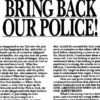
The School of Industrial and Labor Relations released its annual New York at Work Report, addressing a broad set of labor issues affecting workers in the state. The report made policy recommendations for formerly incarcerated people facing barriers to employment, union representation in the green energy economy and challenges affecting the care economy.
The New York at Work’s third edition was released in September — it is annually published around Labor Day — and is the result of a collaborative effort by six key initiatives within the ILR school: the Buffalo Co-Lab, the Climate Jobs Institute, the Criminal Justice and Employment Initiative, the Labor and Employment Law Program, The Worker Institute and the Yang-Tan Institute on Employment and Disability. It aims to provide policymakers with relevant information and recommendations for how to address labor issues in the state.
The report investigated a variety of sectors and topics affecting workers in the state of New York. One issue the report focused on is the treatment of formerly incarcerated individuals and those impacted by the criminal justice system in the workforce. While the New York Legislature’s recent passage of the Clean Slate Act reduces the impact of criminal records in the hiring process, broad barriers still exist for the over 2 million New Yorkers who have a criminal record, particularly those applying for jobs in highly regulated sectors.
“Blanket barriers to employment for [justice-involved] individuals getting into finance [and] for [justice-involved] individuals going into the medical field may have been made with good intentions,” said Jodi Anderson Jr., CJEI director of technological innovation. “But those political and economic realities that created those barriers and policy mandates are no longer applicable in this world, and the challenges we have now are only going to be exacerbated if we keep those same frameworks.”
Anderson says that a more individualized approach that contextualizes the relevance of a criminal record to a candidate’s prospective position would address some of these challenges. On a policy level, the report suggested replacing these broad restrictions with narrower, more discretionary ones and encouraging employers to use individualized assessments.
CJEI has also done work to develop and promote the use of these assessments. The Restorative Record Project is a tool that aims to decrease the overreliance on criminal records in the hiring process by emphasizing factors like community involvement, hobbies and microcredentials.
Leaderboard 2
“[The Restorative Record Project] is engaging employers to say if you’re going to run a background check, will you also look at all the other skills and abilities that may not be reflected on a resume or cover letter and serve as a better indicator of employability than this myopic, dehumanizing criminal record,” said CJEI director Timothy McNutt.
The report also addressed the importance of ensuring that the transition to clean energy is not at the expense of well-paid union work, particularly for marginalized groups. As the New York energy industry responds to climate change, there are concerns that workers will be overlooked in decision-making processes. Prof. Risa Lieberwitz, industrial and labor relations, who is the academic director of The Worker Institute, said that unions are an important avenue for all workers to be represented during this change.
“The labor movement and the clean energy movement really have a great deal in common to make sure that the job transition is done in an equitable way,” Lieberwitz said. “And the other aspect of equity here is to make sure that new jobs include a focus on making sure that women and people of color who had been underrepresented in industry are now being brought in through proportionate representation.”
Newsletter Signup
However, labor movements are struggling to gain traction in clean energy sectors. According to the Worker Institute’s Equity in Focus report, solar and wind energy industries have unionization rates of 10 and 11 percent, which are much lower than the 17 percent unionization rate for coal and natural gas workers. Labor leaders worry that the societal transition to clean energy sources may also be a transition from a unionized job to a low paid non-union job for many impacted workers, the report stated. The New York at Work report recommended a proactive approach towards organizing and unionizing these clean energy facilities to reduce this disparity in union membership.
The report also detailed a response to challenges in the childcare industry, both for paid and unpaid care workers. The United States does not provide paid parental leave, and care services are unaffordable for the majority of Americans working full-time, placing workers — disproportionately women and workers of color — in challenging positions when they are responsible for providing unpaid childcare, according to the report. This unpaid work often affects carers’ ability to maintain paid employment. The report recommended adoption of legislation that will treat care as a public good rather than a private commodity.
“The reality is that whenever you insert market mechanisms in the provision of benefits and services, people will want to turn these into a commodity to make money off of. The minute you do that, you create situations where you are not necessarily meeting the needs of the individual recipient, rather the focus is on the business’ bottom line,” said Prof. Anne Marie Brady, industrial and labor relations, who is the research director in worker rights and equity for The Worker Institute. “[For] whatever you’re providing, whether it’s childcare or something else, you’re thinking of ways you can trim costs that could negatively impact the quality of the benefit or service being provided.”
Brady said that the response to these market mechanisms also leads to low wages for care workers. The Equity in Focus report found that more than 15 percent of child care workers are living below the poverty line in 41 states. A publicly funded program could have provisions that ensure workers receive livable wages and benefits that they are not always receiving under the current system.
The report also found that for all jobs, fewer than 40 percent of New Yorkers earn at or above a living wage and that younger workers and workers from marginalized communities are even less likely to earn a living wage, with 30 percent of Black workers, 26 percent of Hispanic workers and 28 percent of Millennials and Gen Z workers earning a living wage in the state.
For all of these issues, the New York at Work report recommended policies that attempt to address the needs and interests of New York’s diverse workforce.
“Having a commitment through the labor movement to equity in all ways, whether it’s transitioning workers from one job to another, whether it’s bringing in new workers to industry to increase gender and racial equity, whether it’s making sure that there’s adequate childcare so that people who otherwise could not move into those new jobs can have access to either public or very affordable childcare,” Lieberwitz said. “All of that requires the worker voice to be represented by organizations that have the workers’ interests at heart.”
Kate Sanders ’27 is a Sun contributor and can be reached at [email protected].






